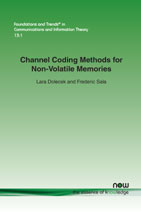Channel Coding Methods for Non-Volatile Memories
By Lara Dolecek, University of California, Los Angeles, USA, dolecek@seas.ucla.edu | Frederic Sala, University of California, Los Angeles, USA, fredsala@ucla.edu
Abstract
Non-volatile memories (NVMs) have emerged as the primary replacement of hard-disk drives for a variety of storage applications, including personal electronics, mobile computing, intelligent vehicles, enterprise storage, data warehousing, and data-intensive computing systems. Channel coding schemes are a necessary tool for ensuring target reliability and performance of NVMs. However, due to operational asymmetries in NVMs, conventional coding approaches – commonly based on designing for the Hamming metric – no longer apply. Given the immediate need for practical solutions and the shortfalls of existing methods, the fast-growing discipline of coding for NVMs has resulted in several key innovations that not only answer the needs of modern storage systems but also directly contribute to the analytical toolbox of coding theory at large. This monograph discusses recent advances in coding for NVMs, covering topics such as error correction coding based on novel algebraic and graph-based methods, rank modulation, rewriting codes, and constrained coding. Our goal for this work is multifold: to illuminate the advantages – as well as challenges – associated with modern NVMs, to present a succinct overview of several exciting recent developments in coding for memories, and, by presenting numerous potential research directions, to inspire other researchers to contribute to this timely and thriving discipline.
Channel Coding Methods for Non-Volatile Memories
Non-volatile memories (NVMs) have emerged as the primary replacement of hard-disk drives for a variety of storage applications, including personal electronics, mobile computing, intelligent vehicles, enterprise storage, data warehousing, and data-intensive computing systems.
Channel Coding Methods for Non-Volatile Memories discusses recent advances in coding for NVMs, covering topics such as error correction coding based on novel algebraic and graph-based methods, rank modulation, rewriting codes, and constrained coding. This monograph illuminates the advantages - as well as challenges - associated with modern NVMs. The authors present a succinct overview of several exciting recent developments in coding for memories and numerous potential research directions. The underlying goal is to inspire other researchers to contribute to this timely and thriving discipline.
Channel Coding Methods for Non-Volatile Memories provides a starting point for any researcher who wants to understand the work that has been conducted so far and join in with their own avenue of research. This is a digestible, yet comprehensive, introduction to the topic for any serious researcher involved in coding for memory systems.
